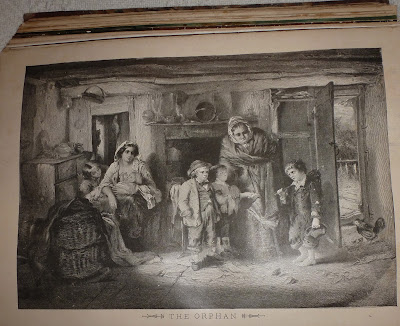Who is this sweet little girl?
Why is her picture on a cover of a magazine including an article about "Blind Man's Bluff"?
Either Mattie or her mother, Elnora Esther Cobb Worthington, created a beautiful scrapbook full of pictures from the DeMorest's Monthly Magazine that I wrote about in a series of blog posts.
In my third post about the scrapbook, I wrote:
Since initially posting about my family's scrapbook initially in A Scrapbook with a Surprise, little did I know how this would challenge me to find out more. I had no idea that so much could be learned from what looked like a simple scrapbook full of period pictures. I shared some of that adventure in Some Logic, Some Help, and "Ask a Librarian" or two ... Gives an Answer. Well the adventure continues and, as the blindfolded person in the above picture, I feel as if the clues are all around me -- IF I could ONLY see them!
Here's my latest update on the adventure.
Discovering that the scrapbook was made from a copy of the Congressional Record (45th Congress, 1877-1879) led to one question after another about not only the Congressional Record but also the history of scrapbooking in an attempt to date the album.
The help of many people made this story possible:
Gena Philibert-Ortega (http://philibertfamily.blogspot.com), Ellen Gruber Garvey (author Writing with Scissors: Am. Scrapbooks from the Civil War to the Harlem Renaissance), Madaleine J Laird (www.kinfolit.com), Connie Reik (Tisch Library, Tufts U), George D Barnum (Agency Historian Government Printing Office), and John J Devine (Boston Public Library, Social Sciences and Governmental Information Department).
Thank you.
Now, you can read the whole story in one article in the Winter 2015 issue of Crossroads, or in my series of blog posts:
A Scrapbook with a Surprise
Some Logic, Some Help, and "Ask a Librarian" or two ... Gives an Answer
Blind Man's Bluff ... Is that What this Scrapbook Playing with Me?
The conclusion, included in the article but not in the above posts is this:
In order to date the scrapbook, just finding the year of publication of the pictures in it and year of publication of the Congressional Record that was being used was not sufficient. We needed to know when the volume became available to the general public. The congressional sessions that it covered, ended in February 1879. After editing, reviewing, etc. it would then go to press. Now, the turn around is about 18 months. How long it was then, is unknown. The clue would be when would it have arrived at the Depository Libraries around the country. The congressmen would have had it to share with constituents about the same time. So, checking with the Boston Public Library, the date it was checked into the BPL collection was 2 September 1884 -- 5 1/2 years after it the congressional session ended.
Discovering that the scrapbook was made from a copy of the Congressional Record (45th Congress, 1877-1879) led to one question after another about not only the Congressional Record but also the history of scrapbooking in an attempt to date the album.
The help of many people made this story possible:
Gena Philibert-Ortega (http://philibertfamily.blogspot.com), Ellen Gruber Garvey (author Writing with Scissors: Am. Scrapbooks from the Civil War to the Harlem Renaissance), Madaleine J Laird (www.kinfolit.com), Connie Reik (Tisch Library, Tufts U), George D Barnum (Agency Historian Government Printing Office), and John J Devine (Boston Public Library, Social Sciences and Governmental Information Department).
Thank you.
Now, you can read the whole story in one article in the Winter 2015 issue of Crossroads, or in my series of blog posts:
A Scrapbook with a Surprise
Some Logic, Some Help, and "Ask a Librarian" or two ... Gives an Answer
Blind Man's Bluff ... Is that What this Scrapbook Playing with Me?
The conclusion, included in the article but not in the above posts is this:
In order to date the scrapbook, just finding the year of publication of the pictures in it and year of publication of the Congressional Record that was being used was not sufficient. We needed to know when the volume became available to the general public. The congressional sessions that it covered, ended in February 1879. After editing, reviewing, etc. it would then go to press. Now, the turn around is about 18 months. How long it was then, is unknown. The clue would be when would it have arrived at the Depository Libraries around the country. The congressmen would have had it to share with constituents about the same time. So, checking with the Boston Public Library, the date it was checked into the BPL collection was 2 September 1884 -- 5 1/2 years after it the congressional session ended.
A post script:
I thought my blog post ended there, with knowing the possible date of the acquisition -- what else was there to learn?
Well, George D Barnum, after seeing the article in the Crossroads, emailed me:
Erica,
I just looked again at the article, and I couldn’t resist passing this thought along: I don’t believe I’d seen a photo of the binding of your scrapbook before. It’s a very standard GPO binding of its time. The marbled paper on the boards of the front and back cover would have been made here at GPO (believe it or not, we still do it for some things, although not the bound Record any more). https://www.youtube.com/watch?v=UiDPY3wprkQ
GB
Thank you George for that last clue and interesting video.
©2015 Erica Dakin Voolich
The link to the page is http://genea-adventures.blogspot.com/2015/02/one-more-scrapbook-revelation-and-ps.html












